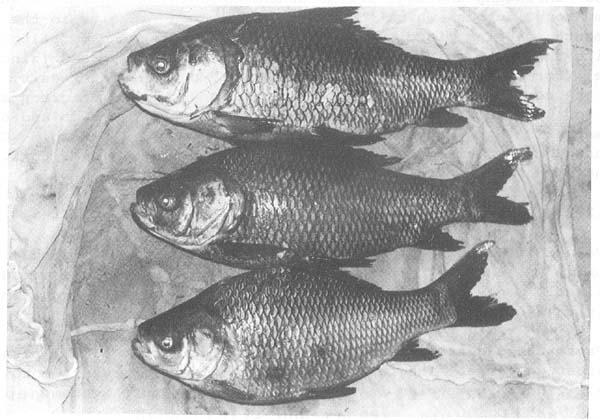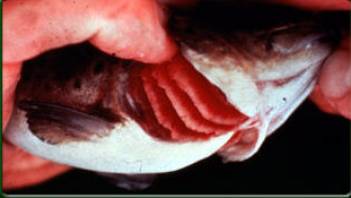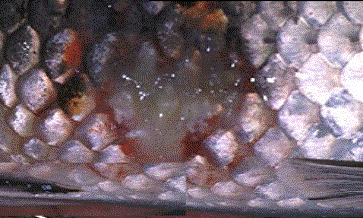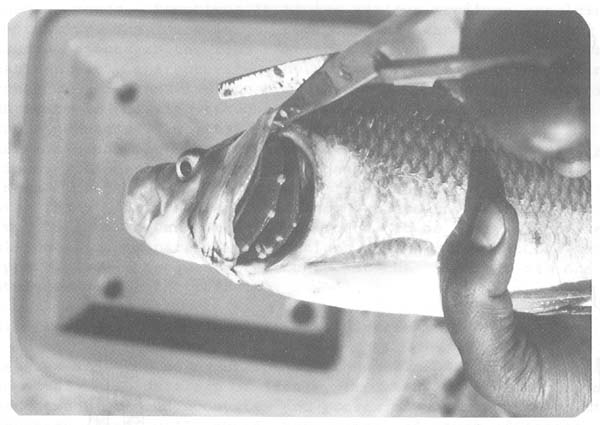|
Disease Management
All the Asiatic carp species cultured under composite fish culture ponds are prone
to many communicable and non-communicable diseases, the most significant among them
are described here under four groups:
Viral Diseases
As far as carp species are concerned, mainly two viral diseases are of importance
(i) Spring viremia of carp (SVC)
Spring Viremia in carps
Etiological Agent: Rhabdovirus
carpio (RVC). The disease was known as “Infectious dropsy of carps”.
Clinical signs: Gathering of
fish at water outflows, dark colouration, lower respiratory rate, hemorrhages especially
over the skin and gills, loss of balance, exophthalmia, inflamed vent, etc. Internally
they show hemorrhages in the viscera, air bladder, etc. Frequently there is secondary
invasion of the tissues by aeromonads and pseudomonads from the intestine resulting
in the bacterial septicaemia.
Vectors: Blood sucking parasites Piscicola geoimetra and
Argulus foliaceus.
Treatment: There is no method of eliminating the virus from the
infected fish.
(ii) Rhabdovirus diseases of grass carp
Etiological Agent: A new serotype
of rhabdovirus similar to spring viremia of carp virus (SVCV) and Rhabdovirus carpio
(RVC).
Clinical signs: Ventral hemorrhagic
inflammation, bleeding in the scale bases, necrotic fins, inflammation of the alimentary
canal, serious liquid deposition in the abdominal cavity, swollen spleen, pale liver,
opacity of the inner wall of the swim bladder with hemorrhages, etc.
Treatment: Control methods
for viral diseases are restricted as there is no chemotherapeutic measures available
at present. Application of antibiotics helps only in prevention of secondary infections.
Bacterial Diseases
Although a number of pathogenic bacteria have been isolated from diseased fishes
cultured in ponds, the following are worth mentioning.
(i) Columnaris disease
Etiological Agent: The causative
agent is a bacterium Flexibacter columnaris.
Clinical signs: An external
infection with lesions appearing on the body surface and gills. Whitish ulcerations,
erosion of the gill lamellae and hemorrhages may also be observed.
Treatment: Environmental improvements,
especially increased oxygenation, control of organic addition, etc., are the most
valuable supportive therapy. Practical control of outbreaks of columnaris is possible
with a number of drugs, including copper sulphate (0.5–1.0 ppm) and potassium
permanganate (2–3 ppm) in pond treatment.
Various other treatments are also employed including dip treatment for 1–2
minutes in 1:2000 copper sulphate colution. If the fish are able to feed, incorporation
of oxytetracycline in the feed at the rate of 8 g/100 kg of fish/day for 10 days
is also effective.
(ii) Bacterial hemorrhagic septicemia
Etiological Agent: Aeromonas
hydrophila and Pseudomonas fluorescens in carp and other species.
Clinical signs: Acute and fatal
septicemias, which may be accompanied by external abscesses, ulcers, exophthalmia
and abdominal distensions
Treatment: Pond treatment with
potassium permanganate (2–3 ppm) followed by addition of oxytetracycline with
feeds at the rate of 70–80 mg/kg fish/day for 10 days are the most effective
and practical measures. Acriflavin was found very effective for such purposes when
used at the rate of 3–10 ppm.

Aeromonas septicemia in Carps
(iii) Carp erythrodermatitis
Etiological Agent: The causative
agent is the Aeromonas salmonicida complex.
Clinical signs: Skin inflammation
is followed by exophthalmia, oedema of all organs and finally anaemia.
Treatment: For the control
and treatment of CE, chemotherapeutics are applied as bath, intraperitoneal injection
or with food. Oxytetracycline at the rate of 7.0–8.0 g/100 kg of fish/day
for 8–10 days, oxytetracycline or chloramphenicol or furazolidone in baths
(80–200 g/m3) or oxytetracycline or chloramphenicol as intraperitoneal injections
at the rate of 10–30 mg/kg have been found to be very effective.
(iv) Bacterial gill disease

Bacterial gill disease
Etiological Agent: Myxobacterial
complex
Clinical signs: Gills affected
causing hyperplasia
Treatment: Short baths for
5–10 minutes in 3% common salt solution has been found to be more effective
than treatment with antibiotics. Two subsequent treatments after an interval of
one week completely cures the disease.
Fungal Diseases

Saprolegia infection
Saproleqnia sp., Branchiomyces sp. and Achlya sp. are
usually implicated in fungal infections, but they are considered to be secondary
invaders following physical or physiological injury brought about by rough handling
or attack by primary pathogens. Branchiomyces sp. is another filamentous
fungus, which obstructs the blood vessels in the gill filaments causing discolouration
and finally dropping off altogether leaving the cartilaginous support exposed. Malachite
green (zinc free grade), formalin, potassium permanganate, copper sulphate, salt,
etc., are the common therapeutics for effective use. Malachite green at the rate
of 0.1 ppm for pond treatment, 1% solution as a swab and 65-ppm concentration as
short bath/dip for 30 seconds are used. Copper sulphate may be used for pond treatment
at the rate of 0.5 to 1.0 ppm depending on total alkalinity.
Parasitic Diseases
Parasitic diseases are usually encountered more frequently than microbial diseases.
The following are some disease causing parasites and their symptoms in Asiatic carps.
|
Protozoa
|
|
Ichthyophthirius
|
Pin-head size white spots on the skin, fins and gills. Presence of ciliated trophozoites
with relatively large horseshoe shaped nucleus.
|
|
Trichodina
|
Presence of saucer-shaped actively moving ciliate parasites on body surface and
gills.
|
|
Myxozoans
|
Presence of cysts, spores on gills, body surface and/or in the squash preparations
of kidney. spleen, air-bladder, etc.
|
|
Crustaceans
|
|
Argulus
|
Haemorrhagic spots, lesions over the body and presence of parasites attached to
fish body by means of suckers and hooks.
|
|
Flukes
|
|
Gyrodactylus / Dactyloqyrus
|
Presence of parasites in gills and skin.
|
|
Diplostomum
|
Small pigmented black nodules over the body surface
|
(Source: FAO)

Myxozoan cysts in Carp gills
Environmental and Nutritional
Diseases
Diseases known to be occurring due to nutritional deficiencies and environmental
disorders are of little importance. Proper monitoring and management of pond ecosystem
and provision of adequate quality of supplementary feed will avoid occurrence of
such diseases which sometimes appear in ill-managed ponds. Liver lipoid disease
(LLD) in catla and gas bubble disease in early fry of rohu are worth mentioning.
Therapy of fish diseases
Therapy can be applied in two ways: external treatments or treatment via diet.
External treatments: There
are two methods of application of external treatments.
Immersion in chemical solution:
The most common method of administering therapeutic agents to fish is immersion
in water soluble compounds. These are baths in lower concentration of chemicals
ranging from short to prolonged periods and dips where the fish are dipped into
a chemical solution of high concentration for a very short period ranging from a
few seconds to 5 minutes.
Swabs:
Swabbing is application of drugs in high concentration when dealing with individual
fish with localized external infections. For better convenience it is desirable
to immobilize the big-sized fish prior to swab application.
Treatment via diet: This method
is usually applied for treating the systemic bacterial diseases or gut parasites
by incorporation of the drug into the feed. Loss of appetite is one of the first
signs of a disease and hence in such cases the use of drugs in proper doses through
supplementary feeding becomes difficult. Leeching of drug is another problem. If
some of the water-soluble drugs are properly mixed with vegetable oil prior to its
final mixing with the feed, such losses may be minimised. Generally, feeding medicated
feed is considered to be a prophylactic rather than a therapeutic measure.
Top
|